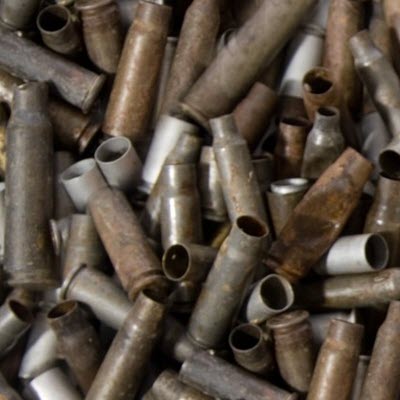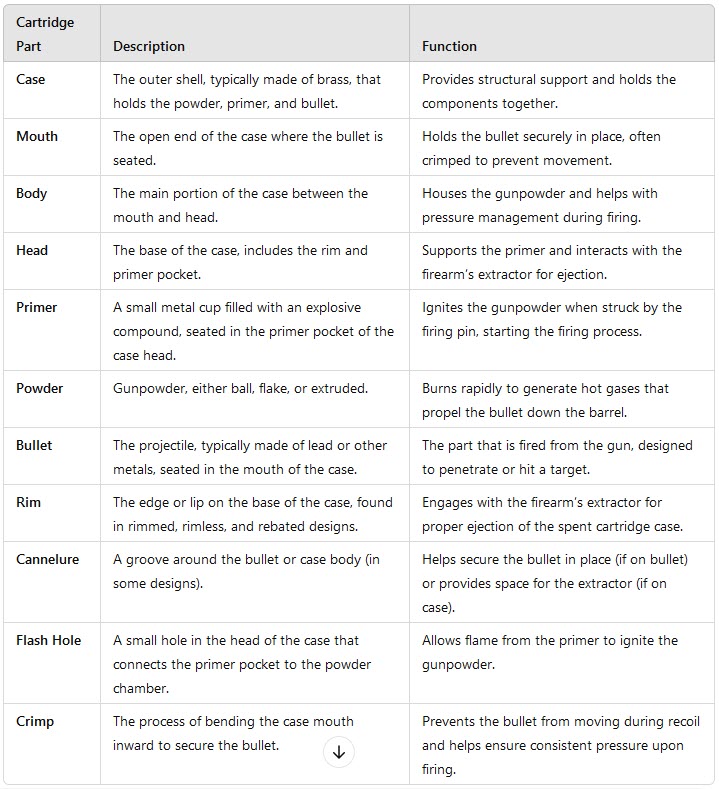Understanding the elements of ammunition is fundamental for anyone serious about shooting, whether for sport, self-defense, or hunting. The cartridge, a seemingly simple item, is actually composed of several complex elements—each critical to the function and safety of your firearm. By breaking down each component, from the case to the primer, powder, and bullet, you’ll gain a deeper appreciation of ammunition and how it impacts your shooting performance.
The Case: The Structural Backbone of a Cartridge
The Body of the Case
The case is the backbone of a cartridge, housing the gunpowder, primer, and bullet. It’s typically made from brass, although some cases can be made from steel or aluminum. This part of the cartridge is often referred to as “brass,” especially when empty. Shaped like a vase, the case is hollow inside, with an opening at the mouth where the bullet is seated and a small hole at the base that holds the primer.
The mouth of the case is an essential part of the design, as it holds the bullet in place before firing. After the bullet is seated in the mouth, the case mouth is crimped to secure the bullet. Crimping helps ensure that the bullet doesn’t move under recoil or pressure. There are two types of crimps: the roll crimp and the taper crimp. The roll crimp pushes the case mouth into a groove, known as a cannelure, on the bullet. This type of crimp is typically used for revolvers. The taper crimp, on the other hand, merely presses the case mouth against the bullet body and is more common in autoloaders.
Cartridge cases can be designed in several ways, with the three most common being straight-wall cases, bottleneck cases, and tapered cases. A straight-wall case features sides that run parallel from the mouth to the base, as seen in many revolver cartridges. The bottleneck case, which is common in rifle rounds, has a body that narrows like a wine bottle, allowing for more powder and greater velocity. The tapered case gradually narrows from base to mouth, as seen in the .30 Carbine.
The Head of the Case
The head is the base of the case and plays a critical role in the structural integrity of the cartridge. It’s where you’ll find the primer pocket, which houses the primer that ignites the powder. The head also includes the rim, which varies depending on the design of the case.
There are three primary types of cartridge heads: rimmed, rimless, and rebated-rim. A rimmed case has a head that is larger in diameter than the case body, most commonly found in revolver cartridges like the .38 Special. A rimless case has a head that is the same diameter as the case body, typical of autoloader cartridges like the 9mm. A rebated-rim case has a head that is smaller in diameter than the case body. While rare, this design can still be found in some autoloader rounds.
The primer pocket sits at the center of the head. It’s a small depression where the primer is inserted. In a centerfire cartridge, a flash hole allows flame from the primer to ignite the powder.
Powder: The Fuel That Propels the Bullet
The gunpowder, or powder, inside the case is the propellant that forces the bullet down the barrel when ignited. Unlike high explosives, gunpowder doesn’t detonate; it burns rapidly, generating large amounts of hot gas. The expanding gases create pressure inside the case, which propels the bullet out of the case mouth and down the gun barrel.
There are many types of powder used in ammunition, typically classified by their grain shape. The three most common types are ball powder, extruded powder, and flake powder. Each has its own burn rate, which affects how quickly the powder ignites and how much pressure it generates. This burn rate is critical because it directly impacts the chamber pressure and the velocity of the bullet.
For reloaders, understanding the burn rates of different powders is essential. Using a powder that burns too quickly or too slowly can cause dangerous spikes in pressure or reduce the performance of your ammunition.
Primer: Igniting the Powder
The primer is a small but essential component that ignites the powder. Located in the primer pocket at the base of the case, it consists of a metal cup containing an explosive material. When struck by the firing pin, the primer detonates, sending a flame through the flash hole into the powder charge inside the case. This ignition process is what starts the chain reaction that sends the bullet downrange.
Primers come in two primary types: Boxer primers and Berdan primers. Boxer primers, the most common type in the U.S., feature a single flash hole and a self-contained design, making them ideal for reloading. Berdan primers, more common in European ammunition, have two flash holes and require specialized equipment to reload.
Modern ammunition typically uses non-corrosive primers, which don’t produce the salts that can rust your firearm. However, surplus military ammunition, especially from earlier decades, may still feature corrosive primers. If you use corrosive ammunition, be sure to clean your firearm thoroughly to prevent damage.
Bullet: The Business End of the Cartridge
The bullet is the projectile that is fired from the cartridge. While simple in appearance, bullets are highly engineered for different applications. Most bullets are made from lead, sometimes coated with copper or other materials to improve performance. The shape and design of a bullet directly impact its ballistics, from accuracy to how it penetrates a target.
Bullets come in various shapes and sizes, such as hollow points, full metal jackets (FMJ), and soft points, each designed for different purposes. For example, hollow-point bullets are designed to expand upon impact, making them ideal for self-defense, while FMJ bullets are often used for target shooting due to their consistency and lower cost.
SAAMI: Setting the Standards for Ammunition
The Sporting Arms and Ammunition Manufacturers’ Institute (SAAMI) plays a crucial role in ensuring that ammunition is safe and reliable. Established in 1926, SAAMI sets industry standards for ammunition dimensions, maximum pressures, and performance metrics. These standards ensure that when you buy a box of ammunition, it will work safely and effectively in your firearm.
For example, one of the key specifications SAAMI defines is the Maximum Overall Cartridge Length (OAL), which is the length from the base of the case to the tip of the bullet. This measurement is especially important for autoloading firearms, as a cartridge that is too long or too short may cause feeding issues.
SAAMI also sets standards for chamber pressure, ensuring that cartridges produce enough power to function in firearms without causing dangerous pressure spikes. Whether you’re using a high-velocity round like the .223 Remington or a lower-pressure cartridge like the .38 Special, SAAMI specifications guarantee consistent performance.

Optimizing for Performance and Safety
Understanding the components of ammunition and how they work together is vital for anyone who wants to optimize their shooting experience. Whether you’re a competitive shooter, a hunter, or someone focused on self-defense, knowing how the case, primer, powder, and bullet interact will allow you to choose the right ammunition for your needs.
For reloaders, understanding each component’s role is even more crucial. Selecting the right powder for your cartridge, ensuring proper crimping, and choosing a primer that matches your firearm will all contribute to safer and more reliable performance.
The Importance of Ammunition Knowledge
Choosing the right ammunition isn’t just about selecting the correct caliber. It’s about understanding the design, function, and performance of each element of a cartridge. From the case design to the powder burn rate and the type of bullet you use, every component plays a vital role in how your firearm performs.
By following SAAMI standards and understanding how each part of a cartridge works, you can ensure that your ammunition is safe, reliable, and effective. Whether you’re a seasoned shooter or a beginner, this knowledge will help you make informed decisions and enhance your overall shooting experience.



